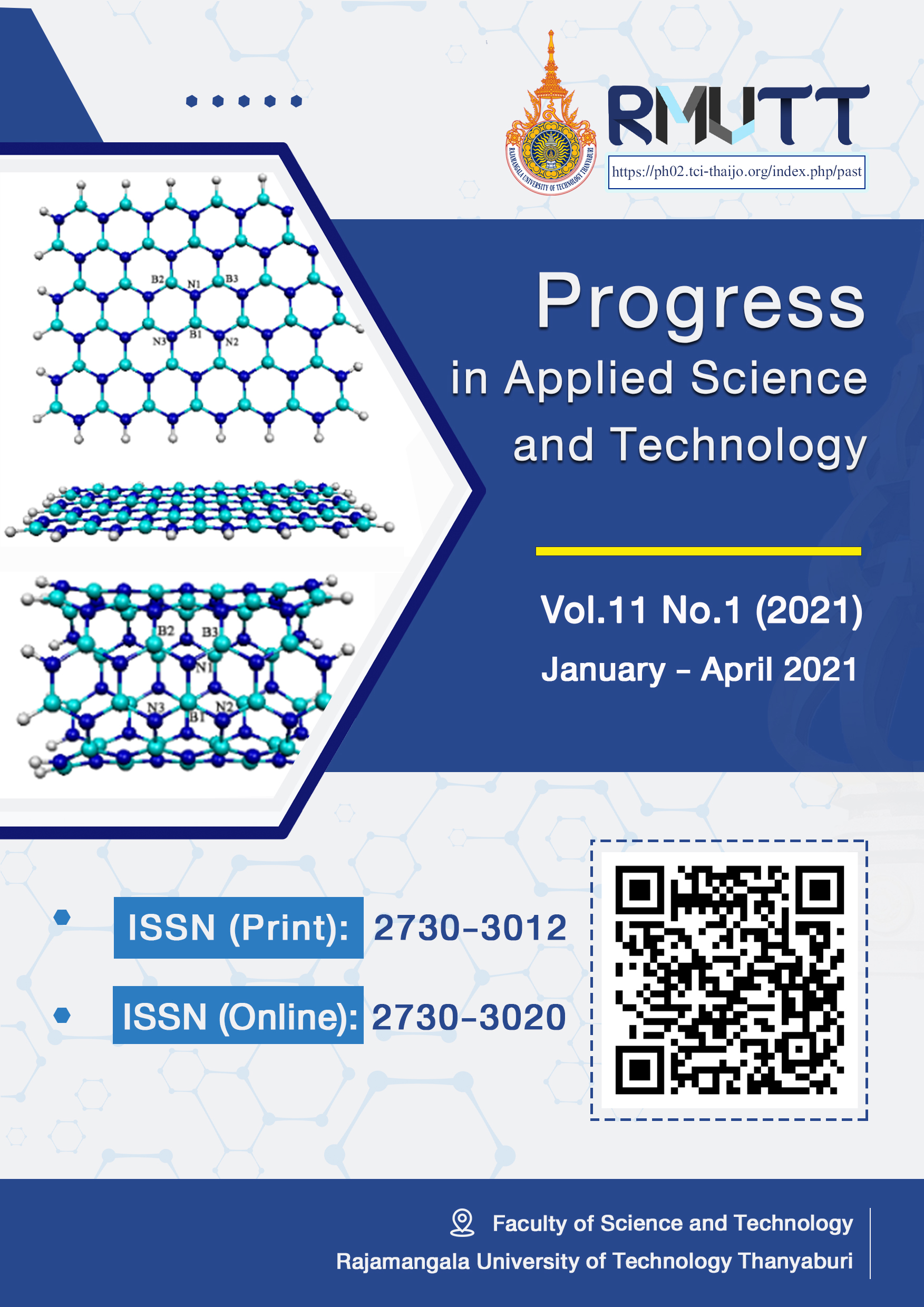Inhibition of the Enzymatic Browning Reaction in Dried Pisang Mas Banana
Main Article Content
Abstract
Enzymatic browning is a major concern in dried Pisang Mas bananas impacting customer satisfaction. Herein, we aimed at developing the methods to inhibit the browning reaction of dried Pisang Mas bananas. The pretreated dried Pisang Mas bananas were evaluated using the color comparison with the commercial products. The results showed the pretreatment of Pisang Mas bananas with the optimum conditions of ascorbic acid at pH 5.5 for 20 min and citric acid at pH 4.5 for 10 min had the ability to inhibit the browning reaction that improved banana’s color closing to the color of the commercial products. Moreover, we proposed pineapple juice and saline solution as the available and low-cost approach to resolve the browning problem. The results showed pretreating Pisang Mas bananas with pineapple juice at pH 4.0 for 10 min and 0.5% w/v saline solution for 20 min was able to inhibit the browning reaction. This finding would be useful for increasing dried banana cost that will be further beneficial to society, economics, and database information.
Article Details
References
Silayoy B, Kloy Kai Kasetsart. 2th ed: Aksornsiam: Bangkok; 2008.
Exported values of Pisang Mas in 2019: Ministry of Commerce.
Ashokkumar K, Elayabalan S, Shobana VG, Sivakumar P and Pandiyan M. Nutritional value of cultivars of Banana (Musa spp.) and its future prospects. J. Pharmacogn. Phytochem. 2018;7(3):2972-2977.
Shaida F, Sulaiman Nor Adlin Md. Y, Ibrahim M. EldeenEng Meng S, Azliana Abu Bakar S, Supriatno, Kheng Leong O. Correlation between total phenolic and mineral contents with antioxidant activity of eight Malaysian bananas (Musa sp.). J. Food Compos. Anal. 2011;24(1):1-10.
Singh B, Singh JP, Kaur A, Singh N. Bioactive compounds in banana and their associated health benefits–A review. Food Chem. 2016;206:1-11.
Pimpen P, Nitiya R. Pisang Mas bananas. 2009. 5. Embs R, Markakis P. The mechanism of sulfite inhibition of browning caused by polyphenol oxidase. J. Food Sci. 1965;30(5):753-8.
Sapers G, Miller R, HICKS K. Uptake and fate of ascorbic acid‐2‐phosphate in infiltrated fruit and vegetable tissue. J. Food Sci. 1991;56(2):419-22.
Pizzocaro F, Torreggiani D, Gilardi G. Inhibition of apple polyphenoloxidase (PPO) by ascorbic acid, citric acid and sodium chloride. J. Food Process. Preserv. 1993;17(1):21-30.
Gonnet J-F. A colorimetric look at the RHS chart—Perspectives for an instrumental determination of colour codes. Hortic. Sci. 1995;70(2):191-206.
Arias E, González J, Peiró J, Oria R, Lopez‐Buesa P. Browning prevention by ascorbic acid and 4‐hexylresorcinol: different mechanisms of action on polyphenol oxidase in the presence and in the absence of substrates. J. Food Sci. 2007;72(9):C464-C70.
Zemel G, Sims C, Marshall M, Balaban M. Low pH inactivation of polyphenoloxidase in apple juice. J. Food Sci. 1990;55(2):562-3.
McEvily AJ, Iyengar R, Otwell WS. Inhibition of enzymatic browning in foods and beverages. Crit. Rev. Food Sci. Nutr. 1992;32(3):253-73.
Lozano-de-gonzalez PG, Barrett DM, Wrolstad RE, Durst RW. Enzymatic browning inhibited in fresh and dried apple rings by pineapple juice. J. Food Sci. 1993;58(2):399-404.
Supapvanich S, Prathaan P, Tepsorn R. Browning inhibition in fresh-cut rose apple fruit cv. Taaptimjaan using konjac glucomannan coating incorporated with pineapple fruit extract. Postharvest Biol. Tec. 2012;73:46-9.
Supapvanich S, Mitrsang P, Srinorkham P. Effects of ‘Queen’and ‘Smooth cayenne’pineapple fruit core extracts on browning inhibition of fresh-cut wax apple fruit during storage. Int. Food Res. J. 2017;24(2):559.
Chaisakdanugull C, Theerakulkait C, Wrolstad RE. Pineapple juice and its fractions in enzymatic browning inhibition of banana [Musa (AAA Group) Gros Michel]. J. Agric. Food Chem. 2007;55(10):4252-7.
Lim WY, Wong CW. Inhibitory effect of chemical and natural anti-browning agents on polyphenol oxidase from ginger (Zingiber officinale Roscoe). J. Food Sci. Technol. 2018;55(8):3001-7.
Alipoorfard F, Jouki M, Tavakolipour H. Application of sodium chloride and quince seed gum pretreatments to prevent enzymatic browning, loss of texture and antioxidant activity of freeze dried pear slices. J. Food Sci. Technol. 2020; 57: 3165–3175.






